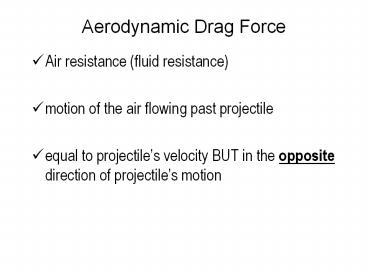Aerodynamic Drag Force - PowerPoint PPT Presentation
Title:
Aerodynamic Drag Force
Description:
Title: BIOMECHANICS APPLICATIONS Author: Robert Vigars Last modified by: rvigars Created Date: 5/24/1997 8:37:16 PM Document presentation format: On-screen Show (4:3) – PowerPoint PPT presentation
Number of Views:175
Avg rating:3.0/5.0
Title: Aerodynamic Drag Force
1
Aerodynamic Drag Force
- Air resistance (fluid resistance)
- motion of the air flowing past projectile
- equal to projectiles velocity BUT in the
opposite direction of projectiles motion
2
Headwind Tailwind
- Vdrag - Vtailwind
- ? flow velocity acting on body
- body v 20mps
- Vtailwind 5mps
- Vres ------------
- Vdrag Vheadwind
- ? flow velocity acting on body
- body v 20mps
- Vheadwind 5mps
- Vres -------------
3
Skin Friction Profile Drag
- ? with area exposed to approaching air flow
- ? with projectile v
- lead side ? pressure
- trail side ? pressure
- main source of Drag
- most noticed _at_ low v
- rubbing of layers of air adjacent to projectile
- ? with flow v, surface size, surface roughness
- secondary concern
4
STREAMLINING
- Achieved by
- 1. decreasing size of area facing oncoming
airflow - 2. tapering leading side - air is not abruptly
moved - Streamlining results in
- A. more laminar flow past body with less wake
- B. less turbulence behind body?less difference
in pressure zones between front and tail of body
5
Mass of Projectile and Drag Effect
- a F m
- a in this case stands for deceleration negative
a - deceleration F m
- deceleration inversely proportional to projectile
m
6
Drag Factors FDrag ½ CD A ? v²
- Skin Friction and Profile Drag
- CD coefficient of drag, indicates how streamlined
a projectile is (low number very streamlined) - A is the frontal area of projectile facing the
flow - ? (rho) is the air density (density less in
warm air and at higher altitude) - v² means if v doubles, drag quadruples
7
Profile Drag increases froma to c as more AREA
is exposed to oncoming airflow AREAa
----------b ----------c ---------- FIG K.10
pg 424
8
FLUID LIFT FORCE
- FL (Lift Force) always perpendicular to direction
of the oncoming air flow - Lift can be upward, downward, lateral
- FL due to difference in pressure zones on
opposite sides of projectile - Bernoullis Principle
- high flow velocity creates ------- pressure zone
- low flow velocity creates -------- pressure zone
9
? flow v on top? p zone on top? p zone on
bottom ?upward Flift
? flow v on top? p zone on top? p zone on
bottom ?downward Flift
10
8-May-2001National Post fromNew
ScientistDavid Anderson disputesDaniel
Bernouillis Principle
11
LIFT DRAG
- Maximize LIFT FORCE by creating an optimal angle
of attack or shaping projectile like an airfoil - Minimize DRAG FORCE with a moderate ATTACK ?
- FL ½ CL A ? v²CL (lift coefficient) A
(area of pressure) ? ( air density)
v² (air flow velocity)
12
FIG K.9 page 424
13
(No Transcript)
14
http//www.grc.nasa.gov/WWW/K-12/airplane/incline.
html
LIFT and DRAG Effects of Inclination of an
AIRFOIL































